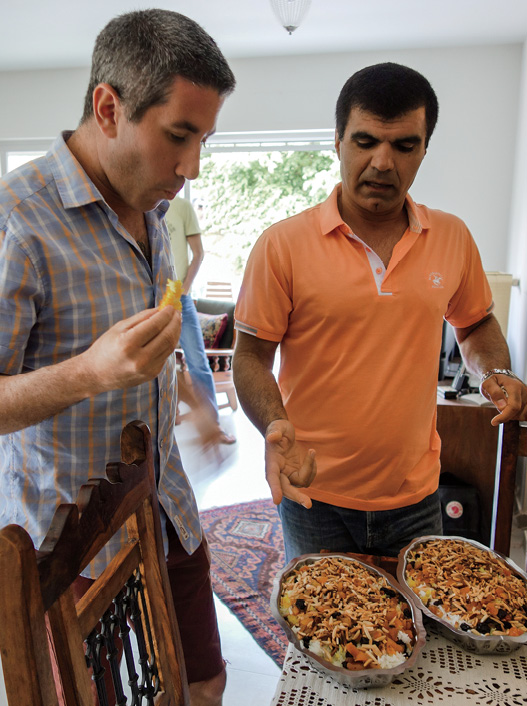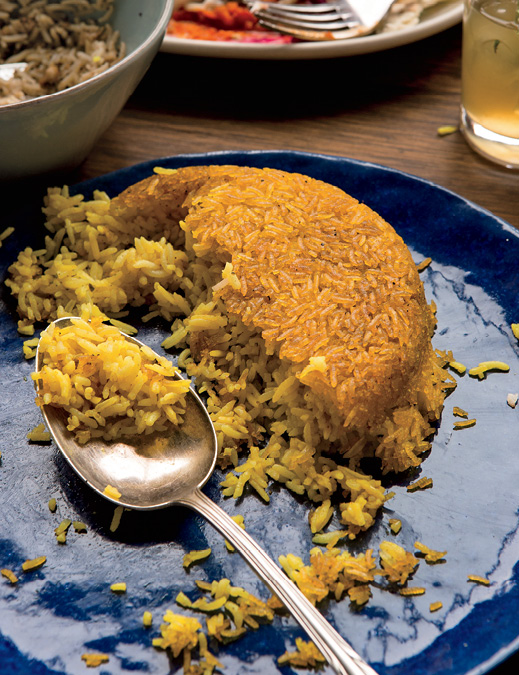
TAMING RICE
For Avi Mor, rice is the bright center of his universe.
“Like a watchful father, Avi awaits the sizzle that signals the tahdig—the prized layer of crispy rice on the bottom.”

For Avi Mor, rice is the bright center of his universe.
There were times in my childhood when virtually all I ate was rice. I once thought this was an ironic beginning for a future chef, but now I see it differently. The more I cook, the more I understand what I love about rice. The craft of cooking is about chasing perfection through repetition and ritual—and never quite getting there. It’s easy to cook with foie gras and truffles (and at their prices, it had better be). But take a cup of rice and some water and salt and try to make something fundamentally delicious and satisfying. And then try to do it a hundred times in a row. It is a Zen all its own. When new cooks come into my kitchen, one of the first things they are asked to do is make rice. These days, young cooks seem to know everything there is to know about sous vide and reverse spherification. Their knives cost more than my car. But cooking a simple dish of rice can often be a very humbling experience. I remember preparing a staff meal early in my career and making a rice pilaf that was badly undercooked. “This almond pilaf is delicious!” my coworkers said as they crunched on raw rice. The rice had no almonds in it. I still don’t know if they were just being polite.
Cooking rice is easy. Cooking it perfectly is incredibly difficult. So many variables can impact the results, from the shape of your pot and the fit of its lid to the starch content of the rice to the calibration of your oven. In cuisines where rice plays an important role, the job of cooking the rice is often the exclusive realm of the master. This is true in Japan, where sushi apprentices work for years before being allowed near the rice. And it is true in Iran, where my half-brother-in-law Avi Mor grew up. In Persian cuisine, rice is the bright center of the universe. It is, literally, the reason for being for many traditional dishes. It would be unthinkable, for example, to make kebabs without having rice to rest them on. Avi was nine years old when his father, a textile merchant, passed away suddenly. With their economic future in question and two siblings already in Israel, Avi’s mother decided to move the entire family there. In 1971, the family left their eighteen-room house in Shiraz for a three-room apartment in Hadera near the coast. The youngest of eight, Avi began helping his mother in the kitchen when he was ten. After five years, he was finally allowed to touch the rice. He has spent the last forty years trying to perfect it.
Avi’s approach in the kitchen is part scientific, part Jedi master. He juggles a half dozen or more variables with each batch: the type of rice and its starch content, the soaking time, the temperature of the soaking water, how long to blanch the rice in boiling water, how much moisture to allow during the steaming. He adjusts each variable based on the destiny of every batch of rice. Chorosh is a genre of stew, heavy on herbs and dried limes, often made with meat and beans. Chorosh without rice is an impossibility, says Avi. Cholo, the plain rice served with chorosh, should be a bit drier to compensate for the moisture of the stew. Polo, a rice dish unto itself once it’s mixed with anything from beans to herbs to dried fruit, should be moist, so it melts in your mouth.
“We are drawn to fireworks, even when they burn us. Yet the simple pot of rice sits there on the stove. And says nothing.”

Draining the water as quickly as possible has everything to do with not damaging the individual grains of rice.
In the kitchen, Avi tends to his rice like a watchful father, looking for the telltale signs: the al dente texture of the blanched grains so that they will become perfectly tender after the final steaming; the sizzling sound that foreshadows the tahdig—the prized layer of crispy caramelized rice on the bottom of the pot; the toasted popcorn fragrance when it has finished cooking. After four decades, Avi is still tinkering, still chasing the perfect pot. He knows that he makes great rice—most of the time. But he also knows that only a fool would consider his learning complete. Even his mother, the undisputed master, would mess up a batch from time to time. If this happened on a Friday evening, it was enough to ruin her whole Sabbath. Avi’s children are now older than he was when he first stepped into the kitchen, but he still doesn’t let them touch the rice.
When I think of Avi, I always picture him carrying a big pot of rice. He brings rice to every family gathering and tends to it lovingly. He fluffs and seasons it, delicately spoons it onto the serving platter, and carefully removes the tahdig for everyone to fight over. The first time I tasted Avi’s rice was in the summer of 2003, a few months before my brother, Dave, died. It was a revelation. When I was younger and plain rice was a staple of my diet, I was made to feel that this was somehow a character flaw. But in Avi’s world, the same dish was considered sacred. Rice culture in Iran is rooted in economic reality—an affordable staple that has sustained a large part of the population for centuries. But its significance transcends its nutritional value. There is something akin to a religious practice in the way that Avi approaches rice—it’s a daily devotion.
By the time I had Avi’s rice, I had been cooking professionally for a few years. I thought I was hot shit. But this rice stopped me in my tracks. He was taking perhaps the plainest ingredient imaginable and elevating it into something sublime.
In Israel, rice has played a critical role in the way Israelis eat, and in establishing a national identity. In the years between 1948 and 1951, the population of Israel more than doubled. When Israel declared independence in 1948, the country was inundated with new immigrants, not just European Jewish refugees from the Holocaust, but also Mizrahim, Jews from the Arab and Muslim world, for whom the existence of a Jewish state had made life very difficult in their native countries. In other words, rice eaters. And a lot of mouths to feed for a country surrounded by hostile nations, without currency reserves or access to credit. Israeli independence was followed by a ten-year period of austerity. Food rationing provided only 1,600 calories a day for the average citizen. My father’s earliest food memory was as a four-year old on the moshav, the collaborative farm community where he grew up. He and his five-year-old cousin were left alone in the house while the grown-ups were at work. When they got hungry, the only food in the refrigerator was a jar of mayonnaise. They polished it off.

Making perfect Persian rice is heady—so challenging, and yet so rewarding.
Morale was low during the early days of the state, and the shortage of rice came to symbolize the hardships faced by its citizens. According to legend, the first prime minister of Israel, David Ben-Gurion, challenged the Osem company, one of Israel’s largest food manufacturers, to quickly develop a wheat-based rice substitute (Israel grew wheat but not rice). Osem came up with a toasted pasta in the shape of rice grains (sort of like orzo) that was marketed as ptitim (shavings) and became known popularly as Ben-Gurion’s rice and later, Israeli couscous. As a boy, my father ate a bowl of ptitim with a bit of rationed margarine almost daily. The austerity period came to an end in the late 1950s, but although some high-tech rice growing is happening today, Israeli couscous has remained a staple, a lasting tribute to the significance of humble rice.
Rice was one of the first foods I loved, and eating Avi’s rice marked a turning point in my professional life. When I returned to the United States in the fall of 2003, I took home a new understanding of my craft. The menu I was cooking at Vetri no longer felt simple and rustic. Now I saw Marc’s food as a daring tightrope walk, each dish stripped to its essence with nowhere to hide its flaws. Even now, as an experienced chef, I am constantly reminding myself that it takes more guts to leave something off the plate than to put something on it. I am lucky to be working during a time when our profession is celebrated for its role in our society. But one side effect of this culture is an unquenchable thirst for what is new. We are drawn to fireworks, even when they burn us. And the simple pot of rice sits there on the stove and says nothing.
I never tire of eating rice, and I never tire of trying to cook the perfect pot. Rice is an affordable, nutritious, and satisfying staple. It connects us to the past, present, and future. It reminds us that the next pot can always be just a little bit better. It reminds us that simplicity is an elusive virtue that is worth pursuing. It reminds us why we cook.